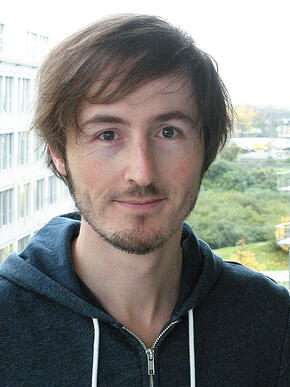

At Giant Swarm, we'd like to make it a habit to write about every new team member that joins the initial seven folks. After Dennis, I'm new hire number two. I joined Giant Swarm in the end of September, more than a month ago. But before writing this blog post, I had to think a bit to come up with a motive for this welcome posts. Let me share it with you:
So here I am, giving you some background. I was born 37 years ago here in Cologne, less than three kilometers from our office. When I left school in 1996, I wanted to become a motion designer. I walked into the office of an on-air design agency that was listed as a dealer of Wacom tablets. They never got onto that list to actually sell those tablets. And I never wanted to buy a tablet from them anyway. I wanted an internship.

I got my internship, not within on-air design though. Along with an entire business unit, my contact person had moved on into a new-formed spin-off focusing on CD-ROM productions, kiosk terminals, and – excitingly at that time – the World Wide Web. The internship got extended to a two year employment. The little agency became the Cologne branch of Pixelpark, and I went on to study design.
In the two years I worked in that agency, I had never spoken to a single end user. Terms like "usability testing" were unknown to me and everyone else around me. And I think that in that time between 1997 and 1999, it was the same in most other agencies. The user was an anonymous entity somewhere on the other end of a too thin phone line, behind a way too small monitor, that restrained us in our creativity. Make it work on 640 by 480 pixels, for 256 colors, with a 56K modem. Right.
For me, that attitude changed during my studies. Here it was much more self-evident that design was ultimately about humans. Thinking about these humans and their particular needs was a standard exercise. And not only thinking about them, but researching them.
Empathy for users first struck me when Prof. Uta Brandes asked us to methodically observe people in some real world situation of our own choice. My team picked the ticket vending machine of our local public transport system. There we were at Cologne main station, watching users as they struggled, as their gaze and their fingers went back and forth over the surface of the machine, looking for clues, looking for some explicit guidance. The longer it took them, the more we felt for them. Many walked away, looking for some better machine, looking for people to help them. After a couple of hours, when we thought we'd seen enough, we started helping people when they seemed to fail.
After these observation sessions, there was no way back. It was evident that the makers of the ticket vending machine hadn't spent a dime on testing how users would actually use their machines. And it occurred to me that my work until then hadn't been much different.
My change of attitude got carried forward through another internship, this time with an enterprise software company in the United States. I was within a team that incorporated user research and usability testing into the development process. We flew to our customers, interviewed our end users, watched them work with their far-from-ideal tools, and came back with ideas to make their life better. We tested them in the usability lab, made developers sit there with us behind the one-way mirror, so they could share the user's pain, but also our excitement when things really improved. It was great.
Fast-forward ten years. There I was again, in an online agency, struggling to sell customers some user research and some usability testing with their online travel booking or product order system. Pretty much "Would you like fries and Coke with your burger?", except that for me it wasn't upselling. It was about doing a proper job. Most didn't want prior research nor user testing though. After all, they hired us as the experts, who should know how to do things and felt they paid enough already.
At that point, in 2011, I decided to quit my agency job. I had two options in mind. The first option: Working on a product, probably with a startup, with actual user focus, and a way to iterate and improve stuff in the long run. The second option: Work self-employed, with data visualization as a focus. The first option didn't work out. I saw no interesting company around me with an open position and a great product I'd like to work on. I went with option two.
Why data visualization? I got captivated with the field during my studies. It's a great way to bring both design skills and technical skills to work, to help people get insights from information. And the time was right. While interactive data visualization in the time of my studies mostly meant Java and Flash, the technology of the Web was now ready for it. But, to make it short: Self-employment wasn't for me. The need to work on projects with deadlines and at the same time acquire new customers. Working mostly on my own in the home office. Not exactly what I had envisioned. Then, out of the blue, option one came back to me. Giant Swarm emailed.
As you probably know by now, we are building a product that enables software developers to run and scale distributed applications with ease. It is a product I can relate to, and one that I believe many of you are waiting for.
"Design is how it works."
–Steve Jobs
Building a great product for you is every Giant Swarm team member's top priority (besides creating an awesome team of happy people, which is the basis of it all). Our user's experience will be a team effort. There won't be a developer in our team who can honestly say that their work doesn't affect our user experience. But, even if design is how it works, as Steve Jobs put it, not everyone who influences how it works is a designer. I am happy to be the designer in this team, bringing a special skill set and perspective into the mix.
As part of my role, I expect to engage in meaningful conversations with you, our users. We can only build a great product for you, if we know what helps you best. As I write this, we have only ourselves and a few alpha users using our platform (If you're interested, our private beta signup form for early access to our product). But all of you can already experience our website, our blog, the blog posts, our beta signup process. Whenever you feel like there is something we could improve, please don't hesitate to contact Giant Swarm or me directly.
You can reach me via email, Skype or Twitter. Giant Swarm can be reached via email and Twitter. And we all listen to you in the comments. I'm looking forward to our conversation!
These Stories on Team
Remote by design, connected by culture – that's the Giant Swarm way.
Discover the perfect blend of work and play with Giant Swarm's Giant Mansions concept. Remote teamwork, redefined as an adventure!
Welcome to Giant Swarm's New Joiners Series where we get to know some of the newest members of the Swarm. This week, we meet Carlos Arilla.
We empower platform teams to provide internal developer platforms that fuel innovation and fast-paced growth.
GET IN TOUCH
General: hello@giantswarm.io
CERTIFIED SERVICE PROVIDER
Comments (1)